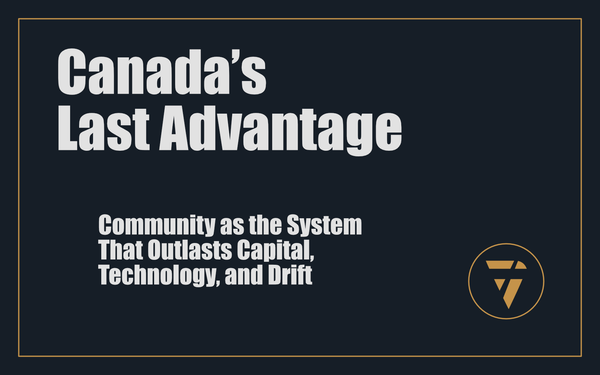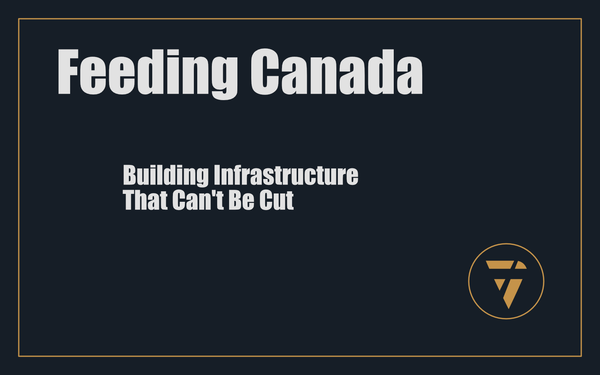Unlocking the Cash

The Capital Gap Hindering Economic Growth
Capital is the lifeblood of economic development. Without it, businesses cannot expand, infrastructure projects stall, and entire communities remain trapped in cycles of stagnation. For major cities, accessing capital is often a matter of leveraging existing networks—banks, investment firms, government incentives, and public-private partnerships are all readily available.
But for rural, remote, and underserved communities, funding remains the single greatest barrier to economic growth. Traditional financial systems fail these regions, leaving businesses and municipalities struggling to secure the resources needed to build sustainable economies.
The question is not whether capital exists, it does. The challenge is how to access, structure, and deploy it effectively in communities that lack the financial infrastructure of urban centres.
1. How Communities Can Access Grants, Private Capital, and Infrastructure Funding
Economic growth does not happen in isolation. It requires multiple funding streams working together, grants from public agencies, private investment from corporations and individuals, and strategic financing for infrastructure. Communities that rely on just one source of funding often find themselves at a standstill. A successful capital strategy involves leveraging multiple sources simultaneously to maximize funding potential.
Government Grants and Public Funding
Governments at the federal, provincial, and municipal levels allocate billions of dollars in grants and incentives each year. These funds support business growth, infrastructure projects, workforce development, and innovation. However, accessing these grants requires expertise and strategy.
Challenges in Securing Government Grants
- Complex applications: Most grants require detailed proposals, financial projections, and impact assessments.
- Highly competitive process: Larger cities often receive priority due to higher population impact.
- Strict compliance requirements: Funds are often restricted to specific uses, limiting flexibility for businesses and municipalities.
Effective Grant Strategies for Communities
- Grant mapping: Identifying all available funding sources and aligning projects with the most relevant programs.
- Professional grant writing: A well-prepared proposal dramatically increases the chances of approval.
- Stacking grants with private capital: Many government programs require matching funds, making it essential to combine public funding with private investment.
Private Investment and Alternative Capital Sources
Public funds alone are not enough to drive sustainable economic growth. Private capital is essential for long-term stability and expansion. However, attracting investors to smaller communities requires deliberate structuring to mitigate perceived risks.
Barriers to Private Investment in Rural and Remote Communities
- Perceived risk: Investors see small markets as unstable and lacking growth potential.
- Lack of investor networks: Many businesses and municipalities in these regions struggle to connect with angel investors, venture capital firms, or corporate partners.
- Low business valuations: Smaller enterprises often lack the revenue histories required for traditional investment structures.
Proven Strategies to Attract Private Investment
- De-risking investment: Using public grants as “anchor funding” to attract private capital.
- Creating regional investment funds: Pooling multiple small businesses or projects into a single investment vehicle spreads risk and increases appeal.
- Leveraging strategic partnerships: Partnering with corporations, development agencies, and community organizations to bring private capital into long-term economic initiatives.
Infrastructure Funding: The Foundation for Economic Growth
Infrastructure is often overlooked as a direct economic driver, yet it is one of the most critical components of a thriving economy. Businesses cannot expand if roads, utilities, and digital connectivity are inadequate. Infrastructure projects require significant capital, and securing funding for them can be one of the most challenging aspects of economic development.
Challenges in Infrastructure Investment
- High costs: Even basic infrastructure projects require millions in upfront capital.
- Slow government approval: Bureaucratic delays can stall projects for years.
- Return on investment concerns: Private investors hesitate to back infrastructure that does not generate direct financial returns.
Strategies to Finance Infrastructure Development
- Public-private partnerships (PPPs): Combining government funds with private investment for shared-risk projects.
- Community bond initiatives: Allowing local businesses and residents to invest directly in infrastructure projects.
- Federal and provincial infrastructure grants: Targeted funding for broadband expansion, energy development, and transportation improvements.
By leveraging multiple sources of capital, communities can move beyond funding limitations and create long-term, self-sustaining growth.
2. Why Traditional Funding Models Fail Many Rural and Remote Communities
Despite the availability of funding, many communities remain locked out of economic growth opportunities. Traditional funding models prioritize low-risk, high-return investments, which often exclude smaller, underserved regions.
Bank Financing Fails Rural Businesses
Traditional lenders such as banks and credit unions play a significant role in economic development, but only when they are willing to take on risk. In many rural areas, banks simply refuse to lend to small businesses due to:
- Limited financial history: Many businesses lack the necessary credit records.
- High collateral requirements: Small businesses may not own significant assets to secure loans.
- Preference for urban investments: Larger markets provide greater profit potential for lenders.
Government Grants Favour Large Urban Centres
While grant programs exist for rural development, they often prioritize projects that demonstrate large-scale population impact. Smaller communities struggle with:
- Limited staff and resources to complete applications.
- Difficulty securing required matching funds.
- Unrealistic project criteria that do not reflect rural realities.
Private Investors Overlook Small Communities
Most private capital flows toward high-growth, scalable industries, leaving rural businesses and infrastructure projects without adequate funding. Conventional investors prefer:
- Markets with higher density and built-in consumer demand.
- Industries with rapid revenue growth potential.
- Businesses with strong financial records and low operational risk.
Without intervention, small communities remain invisible to investors and financial institutions.
3. How MEDA Secures and Deploys Funding Effectively
Manitou Economic Development Agency (MEDA) was created to solve this funding gap by providing structured, proactive capital solutions tailored to the unique needs of underserved communities.
MEDA’s Approach to Securing Capital
1. Grant Writing and Capital Stacking
- Identifies and applies for multiple funding sources simultaneously to increase success rates.
- Structures blended financing models that combine grants, loans, and private capital.
2. Investment Attraction and Fund Structuring
- Creates regional investment funds that pool multiple projects together, spreading risk and increasing appeal for investors.
- Works with businesses to develop investor-ready financial structures that attract outside capital.
3. Infrastructure Development Through Public-Private Partnerships (PPPs)
- Brokers strategic alliances between government agencies, corporations, and investors.
- Designs sustainable financing models to ensure long-term project viability.
Unlocking Capital is the Key to Sustainable Growth
Communities cannot grow without access to capital. Yet, traditional funding models leave too many regions without the financial tools they need to succeed.
MEDA’s approach ensures that capital is not just secured, but strategically deployed, creating lasting economic growth that benefits businesses, residents, and investors alike.
The future belongs to those who innovate their funding strategies. Who is ready to unlock new capital, and build real economic momentum?
This is what I’m working on. Tell me what you think, I enjoy the conversation! Subscribe and follow the work in real time.
Thanks!
B

Communities don’t fail for lack of ideas, they fail for lack of capital. Traditional funding models leave too many behind. The solution? Stack grants, attract private investment, and build sustainable funding structures. Who’s ready to unlock real growth?
PS -






